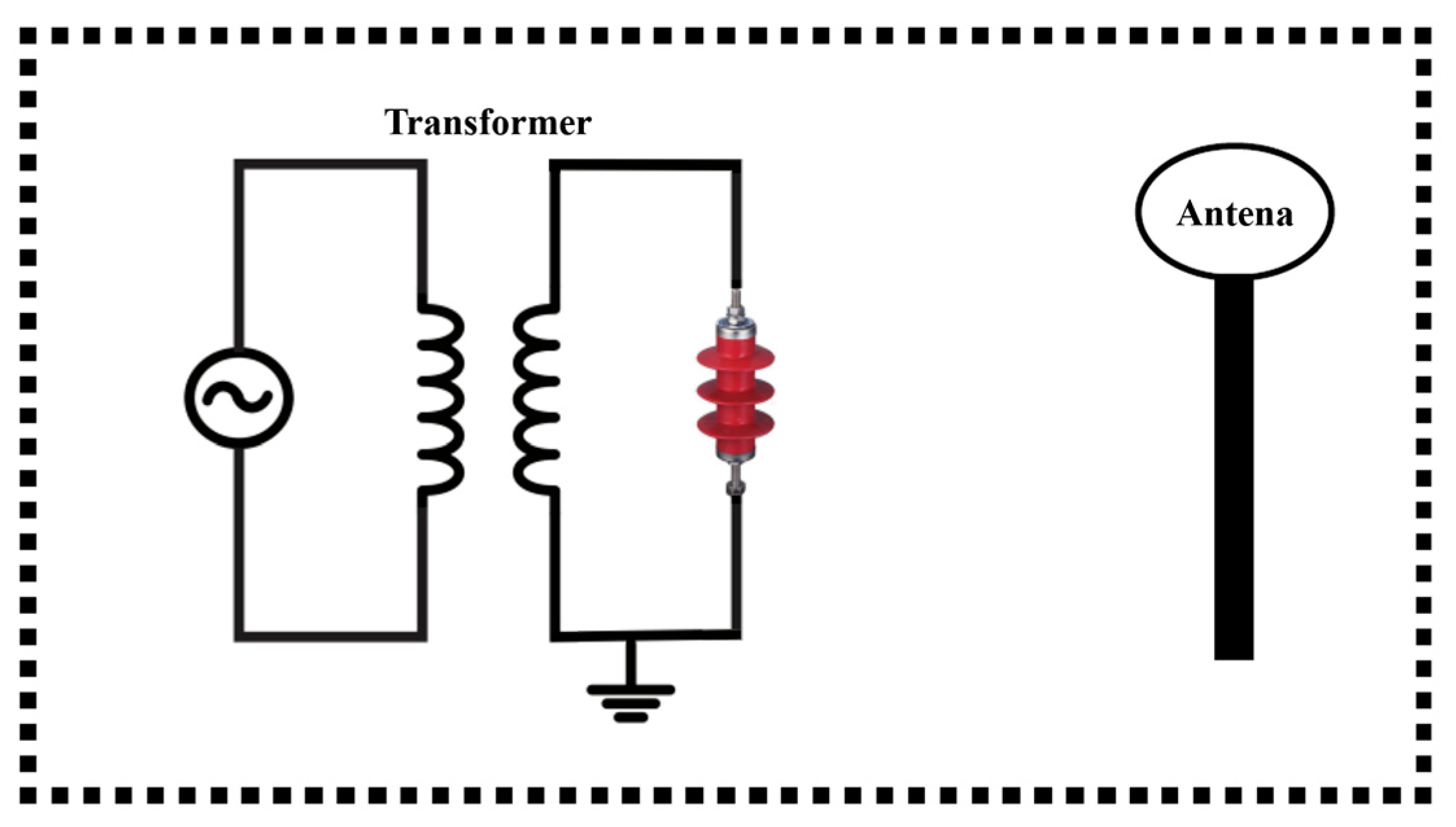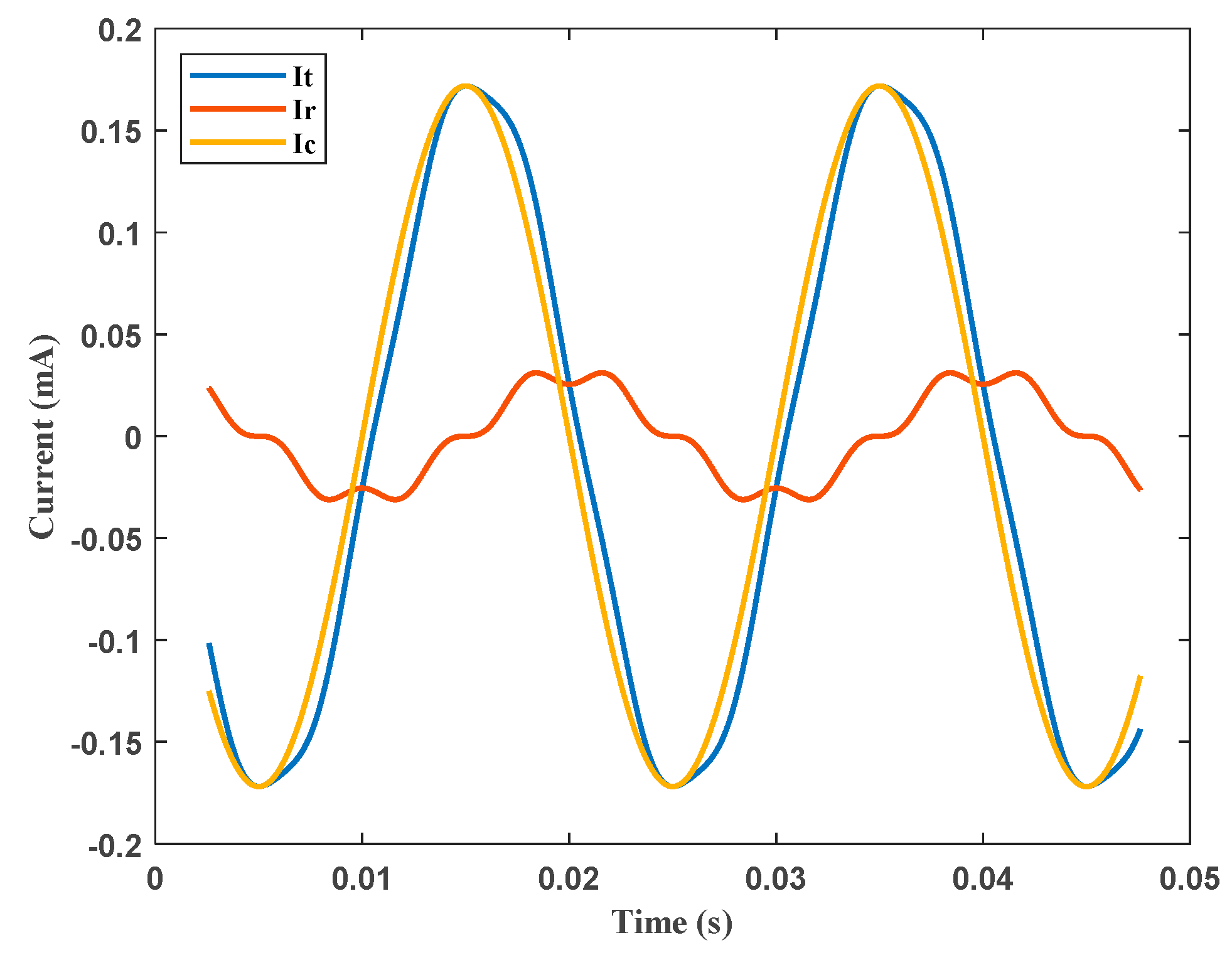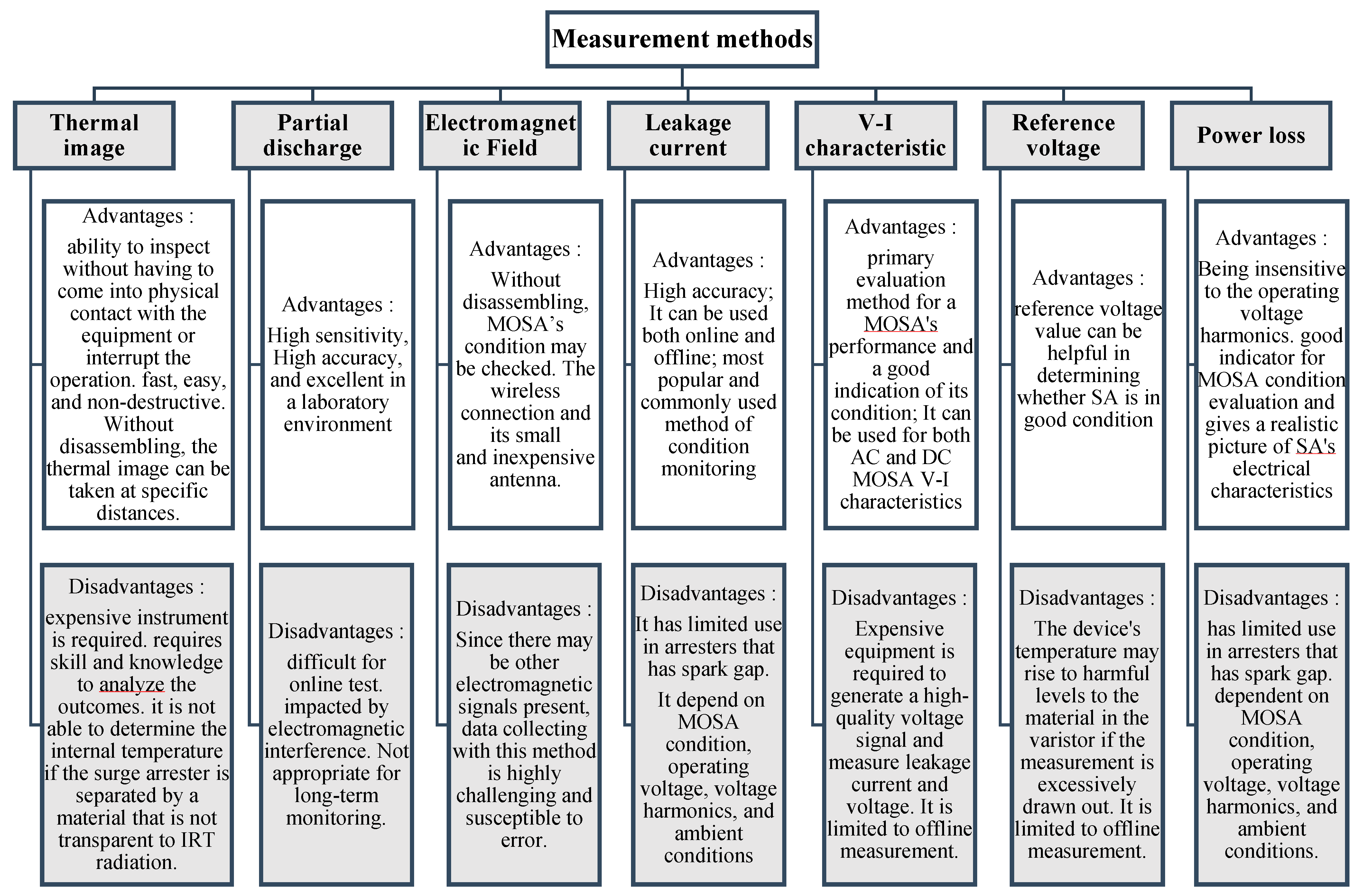A Survey of Diagnostic and Condition Monitoring of Metal Oxide Surge Arrester in the Power Distribution Network
Abstract
:1. Introduction
2. Failures
2.1. Internal Humidity
2.2. Superficial Pollution
2.3. Sealing Loss
2.4. Non-Uniform Voltage Distribution
2.5. Overvoltage due to Switching
2.6. Excessive Lightning Surge Magnitude and Duration
2.7. Varistor Degradation
2.8. Varistor Displacement
3. MOSA Diagnostic and Condition Monitoring Methods
3.1. Thermal Image
3.2. Partial Discharge
3.3. Electromagnetic Field
3.4. Leakage Current
3.5. V-I Characteristics
3.6. Refrence Voltage
3.7. Power Loss
3.8. Impulse Test
3.9. Comparison of Different Diagnostic Methods
3.10. A Look at Upcoming Research
4. Conclusions
Funding
Institutional Review Board Statement
Informed Consent Statement
Conflicts of Interest
References
- Burke, J.J.; Varneckas, V.; Chebli, E.A.; Hoskey, G. Application of MOV and gapped arresters on noneffectively grounded distribution systems. IEEE Trans. Power Deliv. 1991, 6, 794–800. [Google Scholar] [CrossRef]
- Das, J.C. Effects of medium voltage capacitor bank switching surges in an industrial distribution system. In Proceedings of the 1992 IEEE Conference Record of the Industrial and Commercial Power Systems Technical Conference, Pittsburgh, PA, USA, 4–7 May 1992; pp. 57–64. [Google Scholar] [CrossRef]
- Živanović, E.; Živković, M.; Veljković, S. Study of Breakdown Voltage Stability of Gas-Filled Surge Arresters in the Presence of Gamma Radiation. Electronics 2022, 11, 2447. [Google Scholar] [CrossRef]
- Gannac, Y.; Leduc, G.; Pham, C.D.; Crevenat, V. 8/20 and 10/350 Surges Behaviour of a Gas Discharge Tube According to Gas Pressure. Electr. Power Syst. Res. 2021, 197, 107302. [Google Scholar] [CrossRef]
- Abdul-Malek, Z.; Khavari, A.H.; Wooi, C.L.; Moradi, M.; Naderipour, A. A review of modeling ageing behavior and condition monitoring of zinc Oxide Surge Arrester. In Proceedings of the 2015 IEEE Student Conference on Research and Development (SCOReD), Kuala Lumpur, Malaysia, 13–14 December 2015; pp. 733–738. [Google Scholar] [CrossRef]
- Tarfulea, N.; Frigura-Iliasa, F.M.; Vatau, D.; Andea, P.; Balcu, F.; Macarie, A.C. A new algorithm for the design of metal oxide varistor surge arresters. In Proceedings of the 2016 IEEE 16th International Conference on Environment and Electrical Engineering (EEEIC), Florence, Italy, 7–10 June 2016; pp. 1–4. [Google Scholar] [CrossRef]
- Sabiha, N.A.; Mahmood, F.; Abd-Elhady, A.M. Failure Risk Assessment of Surge Arrester Using Paralleled Spark Gap. IEEE Access 2020, 8, 217098–217107. [Google Scholar] [CrossRef]
- Orille-Fernández, Á.L.; Rodríguez, S.B.; Grau Gotés, M.À. Optimization of Surge Arrester’s Location. IEEE Trans. Power Deliv. 2004, 19, 145–150. [Google Scholar] [CrossRef]
- Shariatinasab, R.; Vahidi, B.; Hosseinian, S.H. Statistical Evaluation of Lightning-Related Failures for the Optimal Location of Surge Arresters on the Power Networks. IET Gener. Transm. Distrib. 2009, 3, 129–144. [Google Scholar] [CrossRef]
- Spack-Leigsnering, Y.; Gjonaj, E.; de Gersem, H.; Weiland, T.; Giesel, M.; Hinrichsen, V. Investigation of Thermal Stability for a Station Class Surge Arrester. IEEE J. Multiscale Multiphys. Comput. Technol. 2016, 1, 120–128. [Google Scholar] [CrossRef]
- Ariffin, M.F. Challenges in developing surge arrester failure detection methodologies in TNB distribution network. In Proceedings of the CIRED 2009-20th International Conference and Exhibition on Electricity Distribution-Part 1, Prague, Czech Republic, 08–11 June 2009; pp. 1–4. [Google Scholar]
- Khodsuz, M.; Mirzaie, M. Monitoring and Identification of Metal-Oxide Surge Arrester Conditions Using Multi-Layer Support Vector Machine. IET Gener. Transm. Distrib. 2015, 9, 2501–2508. [Google Scholar] [CrossRef]
- Stojanović, Z.N.; Stojković, Z.M. Evaluation of MOSA Condition Using Leakage Current Method. Int. J. Electr. Power Energy Syst. 2013, 52, 87–95. [Google Scholar] [CrossRef]
- Christodoulou, C.A.; Avgerinos, M.V.; Ekonomou, L.; Gonos, I.F.; Stathopulos, I.A. Measurement of the Resistive Leakage Current in Surge Arresters under Artificial Rain Test and Impulse Voltage Subjection. IET Sci. Meas. Technol. 2009, 3, 256–262. [Google Scholar] [CrossRef] [Green Version]
- Bayadi, A.; Harid, N.; Zehar, K.; Belkhiat, S. Simulation of metal oxide surge arrester dynamic behavior under fast transients. In Proceedings of the International Conference on Power Systems Transients, New Orleans, USA, 28 September–1 October 2003. [Google Scholar]
- Da Silva, D.A.; de Jesus, R.C.; Pissolato, J.; Lahti, K. Partial discharge activity in distribution MOSAs due to internal moisture. In Proceedings of the 2015 International Symposium on Lightning Protection (XIII SIPDA), Balneario Camboriu, Brazil, 28 September–2 October 2015. [Google Scholar]
- Chrzan, K.L. Influence of Moisture and Partial Discharges on the Degradation of High-Voltage Surge Arresters. Eur. Trans. Electr. Power 2004, 14, 175–184. [Google Scholar] [CrossRef] [Green Version]
- Khodsuz, M.; Mirzaie, M. Evaluation of Ultraviolet Ageing, Pollution and Varistor Degradation Effects on Harmonic Contents of Surge Arrester Leakage Current. IET Sci. Meas. Technol. 2015, 9, 979–986. [Google Scholar] [CrossRef]
- Sundararajan, R.; Soundarajan, E.; Mohammed, A.; Graves, J. Multistress Accelerated Aging of Polymer Housed Surge Arresters Under Simulated Coastal Florida Conditions. IEEE Trans. Dielectr. Electr. Insul. 2006, 13, 211–226. [Google Scholar] [CrossRef]
- Heinrich, C.; Hinrichsen, V. Diagnostics and Monitoring of Metal-Oxide Surge Arresters in High-Voltage Networks-Comparison of Existing and Newly Developed Procedures. IEEE Trans. Power Deliv. 2001, 16, 138–143. [Google Scholar] [CrossRef]
- Lira, G.R.S.; Costa, E.G. MOSA Monitoring Technique Based on Analysis of Total Leakage Current. IEEE Trans. Power Deliv. 2013, 28, 1057–1062. [Google Scholar] [CrossRef]
- Lahti, K.; Kannus, K.; Nousiainen, K. Diagnostic Methods in Revealing Internal Moisture in Polymer Housed Metal Oxide Surge Arresters. IEEE Trans. Power Deliv. 2002, 17, 951–956. [Google Scholar] [CrossRef]
- Doorsamy, W.; Bokoro, P. Condition monitoring of metal-oxide surge arresters using leakage current signal analysis. In Proceedings of the 2018 IEEE International Conference on High Voltage Engineering and Application (ICHVE), Athens, Greece, 10–13 September 2018.
- Wong, K.L. Electromagnetic emission based monitoring technique for polymer ZnO surge arresters. IEEE Trans. Dielectr. Electr. Insul. 2006, 13, 181–190. [Google Scholar] [CrossRef]
- Dobric, G.; Stojkovic, Z.; Stojanovic, Z. Experimental Verification of Monitoring Techniques for Metal-Oxide Surge Arrester. IET Gener. Transm. Distrib. 2020, 14, 1021–1030. [Google Scholar] [CrossRef]
- Metwally, I.A.; Eladawy, M.; Feilat, E.A. Online Condition Monitoring of Surge Arresters Based on Third-Harmonic Analysis of Leakage Current. IEEE Trans. Dielectr. Electr. Insul. 2017, 24, 2274–2281. [Google Scholar] [CrossRef]
- Malek, A.; Bashir, N.; Asilah, N. Jurnal Teknologi Thermal Image and Leakage Current Diagnostic as a Tool for Testing and Condition Monitoring of ZnO Surge Arrester. J. Teknol. 2013, 64, 2180–3722. [Google Scholar]
- Wanderley Neto, E.T.; da Costa, E.G.; Maia, M.J.A. Artificial Neural Networks Used for ZnO Arresters Diagnosis. IEEE Trans. Power Deliv. 2009, 24, 1390–1395. [Google Scholar] [CrossRef]
- Lira, G.R.S.; Costa, E.G.; Almeida, C.W.D. Self-organizing maps applied to monitoring and diagnosis of ZnO surge arresters. In Proceedings of the 2010 IEEE/PES Transmission and Distribution Conference and Exposition: Latin America (T&D-LA), Sao Paulo, Brazil, 8–10 November 2010; IEEE: Piscataway, NJ, USA, 2010; pp. 659–664. [Google Scholar]
- Lira, G.R.S.; Costa, E.G.; Ferreira, T.v. Metal-Oxide Surge Arrester Monitoring and Diagnosis by Self-Organizing Maps. Electric Power Systems Research 2014, 108, 315–321. [Google Scholar] [CrossRef]
- Akbar, M.; Ahmad, M. Failure study of metal-oxide surge arresters. Electr. Power Syst. Res. 1999, 50, 79–82. [Google Scholar] [CrossRef]
- Gumede, M.; d’Almaine, G.F. Surge Arrester Faults and Their Causes at EThekwini Electricity. Int. J. Electr. Energy 2014, 2, 39–44. [Google Scholar] [CrossRef]
- Alfredo Osornio-Rios, R.; Antonino-Daviu, J.A.; de Jesus Romero-Troncoso, R. Recent Industrial Applications of Infrared Thermography: A Review. IEEE Trans. Industr. Inform. 2019, 15, 615–625. [Google Scholar] [CrossRef]
- Chou, Y.C.; Yao, L. Automatic Diagnosis System of Electrical Equipment Using Infrared Thermography. In Proceedings of the SoCPaR 2009-Soft Computing and Pattern Recognition, Malacca, Malaysia, 4–7 December 2009; pp. 155–160. [Google Scholar]
- Das, A.K.; Dey, D.; Chatterjee, B.; Dalai, S. A Transfer Learning Approach to Sense the Degree of Surface Pollution for Metal Oxide Surge Arrester Employing Infrared Thermal Imaging. IEEE Sens. J. 2021, 21, 16961–16968. [Google Scholar] [CrossRef]
- Bagavathiappan, S.; Lahiri, B.B.; Saravanan, T.; Philip, J.; Jayakumar, T. Infrared Thermography for Condition Monitoring—A Review. Infrared Phys. Technol. 2013, 60, 35–55. [Google Scholar] [CrossRef]
- Almeida, C.A.L.; Braga, A.P.; Nascimento, S.; Paiva, V.; Martins, H.J.A.; Torres, R.; Caminhas, W.M. Intelligent Thermographic Diagnostic Applied to Surge Arresters: A New Approach. IEEE Trans. Power Deliv. 2009, 24, 751–757. [Google Scholar] [CrossRef]
- Lee, S.; Lee, S.; Lee, B. Analysis of thermal and electrical properties of ZnO arrester block. Curr. Appl. Phys. 2010, 10, 176–180. [Google Scholar] [CrossRef]
- Stefenon, S.F.; Branco, N.W.; Nied, A.; Bertol, D.W.; Finardi, E.C.; Sartori, A.; Meyer, L.H.; Grebogi, R.B. Analysis of Training Techniques of ANN for Classification of Insulators in Electrical Power Systems. IET Gener. Transm. Distrib. 2020, 14, 1591–1597. [Google Scholar] [CrossRef]
- Raymond, W.J.K.; Illias, H.A.; Bakar, A.H.A.; Mokhlis, H. Partial Discharge Classifications: Review of Recent Progress. Measurement 2015, 68, 164–181. [Google Scholar] [CrossRef] [Green Version]
- Chen, L.J.; Tsao, T.P.; Lin, Y.H. New Diagnosis Approach to Epoxy Resin Transformer Partial Discharge Using Acoustic Technology. IEEE Trans. Power Deliv. 2005, 20, 2501–2508. [Google Scholar] [CrossRef]
- Ilkhechi, H.D.; Samimi, M.H. Applications of the Acoustic Method in Partial Discharge Measurement: A Review. IEEE Trans. Dielectr. Electr. Insul. 2021, 28, 42–51. [Google Scholar] [CrossRef]
- Neto, N.F.S.; Stefenon, S.F.; Meyer, L.H.; Bruns, R.; Nied, A.; Seman, L.O.; Gonzalez, G.V.; Leithardt, V.R.Q.; Yow, K.C. A Study of Multilayer Perceptron Networks Applied to Classification of Ceramic Insulators Using Ultrasound. Appl. Sci. 2021, 11, 1592. [Google Scholar] [CrossRef]
- Xu, J.; Kubis, A.; Zhou, K.; Ye, Z.; Luo, L. Electromagnetic Field and Thermal Distribution Optimisation in Shell-Type Traction Transformers. IET Electr. Power Appl. 2013, 7, 627–632. [Google Scholar] [CrossRef]
- Khodsuz, M.; Mirzaie, M. Harmonics Ratios of Resistive Leakage Current as Metal Oxide Surge Arresters Diagnostic Tools. Measurement 2015, 70, 148–155. [Google Scholar] [CrossRef]
- Latiff, N.A.A.; Illias, H.A.; Bakar, A.H.A.; Dabbak, S.Z.A. Measurement and Modelling of Leakage Current Behaviour in ZnO Surge Arresters under Various Applied Voltage Amplitudes and Pollution Conditions. Energies 2018, 11, 875. [Google Scholar] [CrossRef] [Green Version]
- Fu, Z.; Wang, J.; Bretas, A.; Ou, Y.; Zhou, G. Measurement Method for Resistive Current Components of Metal Oxide Surge Arrester in Service. IEEE Trans. Power Deliv. 2018, 33, 2246–2253. [Google Scholar] [CrossRef]
- Das, A.K.; Dalai, S. Recent Development in Condition Monitoring Methodologies of MOSA Employing Leakage Current Signal: A Review. IEEE Sens. J. 2021, 21, 14559–14568. [Google Scholar] [CrossRef]
- Abdul-Malek, Z.; Yusoff, N.; Yousof, M.F.M. Field experience on surge arrester condition monitoring—Modified Shifted Current Method. In Proceedings of the 45th International Universities Power Engineering Conference UPEC 2010, Cardiff, UK, 31 August–3 September 2010; pp. 1–5. [Google Scholar]
- Khodsuz, M.; Mirzaie, M.; Seyyedbarzegar, S. Metal Oxide Surge Arrester Condition Monitoring Based on Analysis of Leakage Current Components. Int. J. Electr. Power Energy Syst. 2015, 66, 188–193. [Google Scholar] [CrossRef]
- Khodsuz, M.; Mirzaie, M. An Improved Time-Delay Addition Method for MOSA Resistive Leakage Current Extraction under Applied Harmonic Voltage. Measurement 2016, 77, 327–334. [Google Scholar] [CrossRef]
- Munir, A.; Abdul-Malek, Z.; Arshad, R.N. Resistive Component Extraction of Leakage Current in Metal Oxide Surge Arrester: A Hybrid Method. Measurement 2021, 173, 108588. [Google Scholar] [CrossRef]
- Barannik, M.; Kolobov, V. System for Monitoring the Condition of Metal-Oxide Surge Arresters in Service. In Proceedings of the 2020 International Multi-Conference on Industrial Engineering and Modern Technologies (FarEastCon), Vladivostok, Russia, 6–9 October 2020; pp. 1–6. [Google Scholar] [CrossRef]
- Khodsuz, M.; dan Seyyedbarzegar, S.M. Surge Arrester Monitoring under Different Operating Conditions Using BeesANFIS. Iran. J. Electr. Electron. Eng. 2019, 1, 151–160. [Google Scholar]
- Silva, D.A.; Costa, E.C.M.; Franco, J.L.; Abreu, S.R.; Jesus, R.C.; Antonionni, M.; Pissolato, J. Polymer Surge Arresters: Degradation versus Electrical Performance. In Proceedings of the 2012 IEEE Electrical Power and Energy Conference, EPEC 2012, London, ON, Canada, 10–12 October 2012; pp. 63–68. [Google Scholar]
- Abdul-Malek, Z.; Bashir, N. Condition Monitoring of Zinc Oxide Surge Arresters. In Practical Applications and Solutions Using LabVIEW™ Software; InTech: Vienna, Austria, 2011; pp. 253–270. [Google Scholar]
- Seyyedbarzegar, S.M.; Mirzaie, M. Thermal Balance Diagram Modelling of Surge Arrester for Thermal Stability Analysis Considering ZnO Varistor Degradation Effect. IET Gener. Transm. Distrib. 2016, 10, 1570–1581. [Google Scholar] [CrossRef]
- Woodworth, J.J. ArresterFacts 027 Arrester Reference Voltage Copyright ArresterWorks. ArresterWoks: Buffalo, NY, USA, 2011. [Google Scholar]
- Mardira, K.P.; Saha, T.K.; Sutton, R.A. Investigation of diagnostic techniques for metal oxide surge arresters. IEEE Trans. Dielectr. Electr. Insul. 2005, 12, 50–59. [Google Scholar] [CrossRef]
- He, J.; Zeng, R.; Chen, S.; Tu, Y. Thermal Characteristics of High-Voltage Whole-Solid-Insulated Polymeric ZnO Surge Arrester. IEEE Power Eng. Rev. 2008, 22, 62. [Google Scholar] [CrossRef]
- Seyyedbarzegar, S.M.; Mirzaie, M. Heat Transfer Analysis of Metal Oxide Surge Arrester under Power Frequency Applied Voltage. Energy 2015, 93, 141–153. [Google Scholar] [CrossRef]
- Miller, D.R.; Woodworth, J.J.; Daley, C.W. Watts loss of polymer housed surge arresters in a simulated Florida coastal climate. IEEE Trans. Power Deliv. 1999, 14, 940–947. [Google Scholar] [CrossRef]
- IEC 60099-4; Surge Arresters: Part 4: Metal-Oxide Surge Arresters without Gaps for a.c. Systems. 2nd ed. IEC: Geneva, Switzerland, 2004.
- Abb, A.B. High Voltage Surge Arresters-Buyer’s Guide, Ludvika, Sweden, June 2009. Available online: http://www.abb.com/product/se/9AAC710009.aspx (accessed on 18 October 2022).









| References | [22] | [11] | [23] | [20] | [24] | [25] | [26] | [16] | [27] | This Paper |
|---|---|---|---|---|---|---|---|---|---|---|
| Leakage current | ✓ | ✓ | ✓ | ✓ | ✓ | ✓ | ✓ | ✓ | ✓ | ✓ |
| Thermal image | - | ✓ | - | - | ✓ | - | - | - | ✓ | ✓ |
| Partial discharge | ✓ | ✓ | - | - | - | - | - | ✓ | - | ✓ |
| Resistive current | ✓ | - | - | ✓ | - | ✓ | ✓ | - | ✓ | ✓ |
| V-I characteristic | - | - | ✓ | ✓ | - | ✓ | - | - | - | ✓ |
| Power loss | ✓ | - | - | ✓ | - | ✓ | ✓ | ✓ | - | ✓ |
| Reference voltage | - | - | ✓ | ✓ | - | - | ✓ | - | - | ✓ |
| Electromagnetic | - | - | - | - | ✓ | - | - | - | - | ✓ |
| Reference | Properties | Advantage | Disadvantage |
|---|---|---|---|
| [37] | Uses thermovision to detect arrester failure and the probability of a fault. Employs a digital image processing technique based on the watershed transform, and uses the neuro-fuzzy network. | A non-destructive procedure; a decision-making instrument for identifying surge arrester faults. In addition to normal and faulty conditions, the surge arrester includes the following intermediate conditions: light and suspicious. | If the parameters of a thermogram alter drastically, the tool may not produce reliable data. The thermogram’s placement should be properly specified. |
| [16] | After immersion testing, it observes the partial discharge and leakage current on eight surge arresters. | It assesses the behavioral relationship between internal humidity and partial discharge and MOSA degradation. | The measurement of partial discharge was less accurate than power loss. The electrical partial discharge measurements are particularly susceptible to external noise. |
| [24] | Utilizes the electromagnetic emission method to identify partial discharge and lightning arrester surface flaws. | As a diagnostic technique, the WVD analysis can be employed with the use of a signal processing algorithm. It has a wireless connection and a small and inexpensive antenna. | Since there may be other electromagnetic signals present, data collecting with this method is highly challenging and is susceptible to errors. |
| [50] | Analyzes leakage currents to assess the condition of the arrester. | It creates a database of medium- and high-voltage arresters with varying functioning conditions. It uses signal processing in MATLAB and the simulation of the leakage current in ATP-EMTP to verify its analysis. | The extraction result of resistive and capacitive components of the leakage current may be unreliable, and online testing is difficult. |
| [12] | Classifies arresters using experimental tests and the multi-layer support vector machine method (SVM). | The classifier performs exceptionally well regarding training speed and reliability. It can categorize samples into some categories. | The SVM cannot detect the error of specific information; it can only categorize samples into some categories. The classification performance is heavily dependent on the MOSA parameters chosen; the algorithm cannot choose the MOSA parameters automatically. |
| [13] | The MOSA’s condition assessment utilizes a leakage current analysis technique at the operating condition. | The applicability of specific indicators for evaluating the MOSA’s condition was assessed. There has been a suggestion for a solution to reduce the impact of voltage harmonics and fluctuation on the result of the leakage current analysis. | The difficulty of simultaneous current and voltage measurements at the network and higher harmonics may make tests invalid. |
Publisher’s Note: MDPI stays neutral with regard to jurisdictional claims in published maps and institutional affiliations. |
© 2022 by the authors. Licensee MDPI, Basel, Switzerland. This article is an open access article distributed under the terms and conditions of the Creative Commons Attribution (CC BY) license (https://creativecommons.org/licenses/by/4.0/).
Share and Cite
Ranjbar, B.; Darvishi, A.; Dashti, R.; Shaker, H.R. A Survey of Diagnostic and Condition Monitoring of Metal Oxide Surge Arrester in the Power Distribution Network. Energies 2022, 15, 8091. https://doi.org/10.3390/en15218091
Ranjbar B, Darvishi A, Dashti R, Shaker HR. A Survey of Diagnostic and Condition Monitoring of Metal Oxide Surge Arrester in the Power Distribution Network. Energies. 2022; 15(21):8091. https://doi.org/10.3390/en15218091
Chicago/Turabian StyleRanjbar, Behnam, Ali Darvishi, Rahman Dashti, and Hamid Reza Shaker. 2022. "A Survey of Diagnostic and Condition Monitoring of Metal Oxide Surge Arrester in the Power Distribution Network" Energies 15, no. 21: 8091. https://doi.org/10.3390/en15218091
APA StyleRanjbar, B., Darvishi, A., Dashti, R., & Shaker, H. R. (2022). A Survey of Diagnostic and Condition Monitoring of Metal Oxide Surge Arrester in the Power Distribution Network. Energies, 15(21), 8091. https://doi.org/10.3390/en15218091







